Zander: forgotten between Tsiolkovsky and Korolev
August 23 marks the 130th anniversary of the birth of Friedrich Zander. There will be no big celebrations - Friedrich Arturovich died in 1933, he managed to take part only at the very beginning of the Soviet rocket and space industry. Alas, not all pioneers and enthusiasts could see the realization of their dreams. But to remember their work is useful and correct.
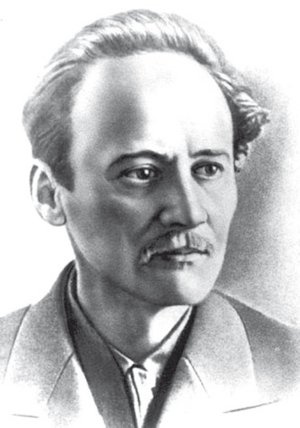
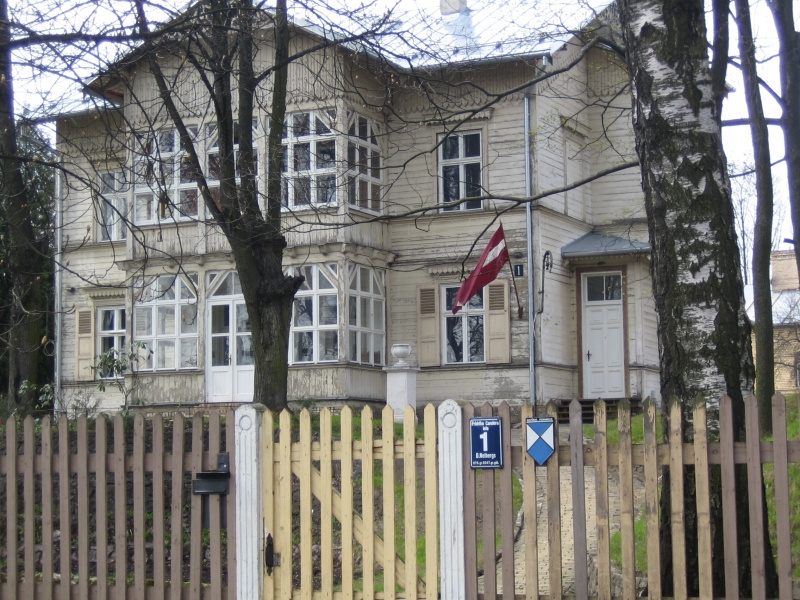
The house where Zander spent his childhood, photo Smig / Wikipedia
Friedrich Arturovich Zander was born on August 23, 1887 (August 11, 1887) in a family of intellectuals in Riga. My father came from a merchant family and worked as a doctor, his mother came from a family of a musician. Frederick was the fourth child. When he was two years old, his mother died in childbirth. Father married a second time, but actively participated in the upbringing of children. Zander wrote in his autobiography:
His father’s comrades were sailors, Frederick had been to the nautical school, met navigational instruments and was interested in astronomy. My father had a large library in which Zander most of all loved Jules Verne - “From the Earth to the Moon” and “Around the Moon”. In general, it is worth noting that Jules Verne was noted in the biographies of many pioneers of rocket technology, his books, albeit after thirty years, finally got a generation that began to embody the dreams of space travel.
In 1896, Friedrich was identified in a private preparatory school. My father’s personal abilities and help allowed us to study a three-year program in two years. In 1898, Zander was enrolled in the first class of the Riga City Real School (the closest modern analogy is the College of Technical Sciences).
In 1905, Zander graduated from college as the best graduate and, according to the privilege granted to the first graduate, was enrolled in the mechanical department of the Riga Polytechnic Institute. Alas, frightened by the revolution of 1905, the administration temporarily closes the institute, and Zander leaves for Danzig (now Gdansk, Poland), where he is a student at the Higher Technical School in the engineering department. In 1907, the institute was reopened, and Zander returned to the “alma mater”, where he studied until 1914.
In parallel with his studies in 1908, he participates in the activities of the First Riga Student Society of Aeronautics and Flight Engineering, where he builds gliders and promotes the idea of flying heavier than air vehicles.
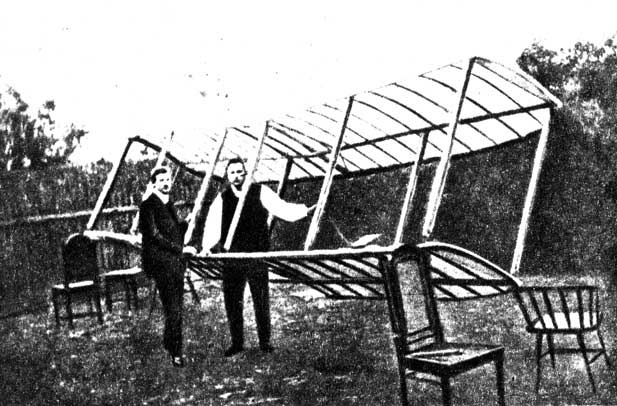
1908, the glider was built by the society, Zander on the left
September 18, 1908 Zander turns on a special notebook “Space (ether) ships that will provide communication between the stars. Movement in the world space ", which regularly records calculations and ideas on space issues. Over time, the notebook turns into a unique reference book, and if it were published in the 20s, Zander could have received world fame. Alas, it was not done. Worse, Zander kept records with a shorthand code, and so far not all the information from the exercise book has been deciphered.
In 1909, Zander was overshadowed by the idea of using spent rocket stages as fuel. Winged vehicles and the idea of burning metal in a rocket engine will be noticeable throughout its subsequent work. Until now, mankind has not reached such a level that in flight it can disassemble the previous stage and burn it in the engine of the next stage, but the idea of a wasteless space flight is in principle correct.
In the same year there was a confrontation of Mars. On the wave of public interest, the aeronautics society is actively and successfully engaged in the popularization of astronomy. In 1910, the comet of Halley appears very much in place, and in 1912 a solar eclipse occurs. These events are also used for popularization.
In 1910, Zander comes up with options for a space elevator - a station hanging at the point of equal attraction of the Earth and the Moon, or even a connection of the Earth and the Moon with a cable. But the calculations are implacable - the best steel of that time will not withstand such loads. Now, by the way, materials have appeared that can be used to build a lunar space elevator, and these are not metals, but Kevlar / daynema / aramid from which lines are made.
In June of the same year, Zander proposes to use the Earth’s magnetic field for the motion of spacecraft. This idea has now been successfully implemented - the magnetic field is used to orient the satellites , and experiments are conducted with acceleration / deceleration based on it.
In 1912, Zander independently came up with the idea of dropping the spent rocket stages. I remind you that Tsiolkovsky offered fuel overflow between individual ships. Only Goddard has this idea fixed earlier (in 1909).
In 1914, Friedrich graduated with honors from the institute and got a job at the “Provodnik” factory. The diploma with honors gave a wide freedom to choose a specialty, and Zander wanted to work with rubber, because it would have to play a large role "in the manufacture of airtight clothing, etc., items necessary for interplanetary travel." In 1915, because of the First World War, the plant was evacuated to Moscow, then, after the revolution, they were liquidated, but Zander did not return to Riga, “because Moscow with the Khodynsky field is an aviation center” . Turning slightly aside, the Khodynka field became an important milestone in the life of more than one pioneer of the Soviet rocket science, and B.Ye. Chertok.
In the years 1915-1917, Zander conducts experiments with greenhouses of "aviation lightness", studying the life support of spacecraft, growing vegetables in charcoal. The manuscript is kept in the archives on 163 pages with the results of the work, but, alas, again in the shorthand record. In 1917 he conducted experiments with molten metal, studying the possibility of using it in a rocket engine.
In 1919, arranged for the plant "Motor". Many papers on the first Soviet aircraft engines store his calculations. Participates in the development of engines M-11, M-15, M-26 and others. In the same year, he invents and sends to the General Directorate of Aviation Plants and the Directorate of the Air Force a project of an injection jet engine working on liquid oxygen and oil. The injector was invented before it, but the perspective of this type of fuel injection into the cylinder at that time was not obvious. Repeatedly makes reports on the engine, and experience with liquid oxygen will be very useful to him later.
At the end of 1921 or the beginning of 1922, he meets with Vladimir Lenin and talks with him about interplanetary communications. Zander later noted that he was struck by Lenin’s enormous horizons and his energy. At least partly influenced by this meeting, Friedrich Arturovich took an annual unpaid leave to work on an interplanetary spacecraft project. During work without a salary, he falls into need, he is forced to sell a telescope. The workers of the plant "Motor" from his salary deduct him a two-month salary. A year later, in general terms, finishes the project and returns to the plant.
The result of the work being done since about 1920 is the project of a winged spaceplane. In the dense layers of the atmosphere, he had to use a highly efficient piston engine, rising into rarefied layers - switch to rocket. At the acceleration site, the main wings were to be drawn into the hull, disassembled and used as fuel. The spaceplane should have had small wings to land back to Earth. In space, it was proposed to use the solar sail. At each stage of the flight, the most efficient engine would work, and the aerodynamic quality of the vehicle would also be maximally used.

The appearance of the spaceplane Zander
By 1924, the project was completed, Zander began to make presentations, filed the author's application for the invention, and also published an article in the journal "Technology and Life." He participates in a three-day dispute about flights to other worlds.

Dispute billboard
In the same year participates in the creation of the Society of interplanetary communications.
In the years 1925-1926, in parallel with his work, Zander is engaged in popularization - lectures in Leningrad, Ryazan, Tula, Kharkov, and Saratov attend lectures. Lectures are a great success, after the performance disputes begin. Alas, in 1925, the Society of Interplanetary Communications falls apart.
In 1927, the first World exhibition of interplanetary vehicles and mechanisms opened in Moscow. The exhibition was small and budget, but this was more than offset by the epic ( here more with the photo ). To an untrained person, it seemed that the Universe was already in his pocket. Alas, at the exhibition were presented mock-ups of projects, which in the overwhelming majority have not yet flown, but only thirty years left before the first satellite. In the corner of the room was Zander's stand.

By 1928, the project includes a composite rocket with a lot of side blocks with engines and tanks with fuel.
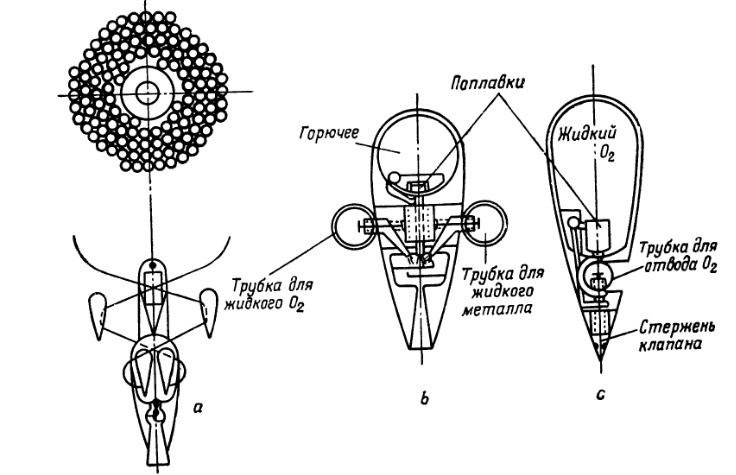
In reality, it did not materialize, but such schemes are often created in the Kerbal Space Program, because they are really effective. Next time you play KSP, remember Zander ...
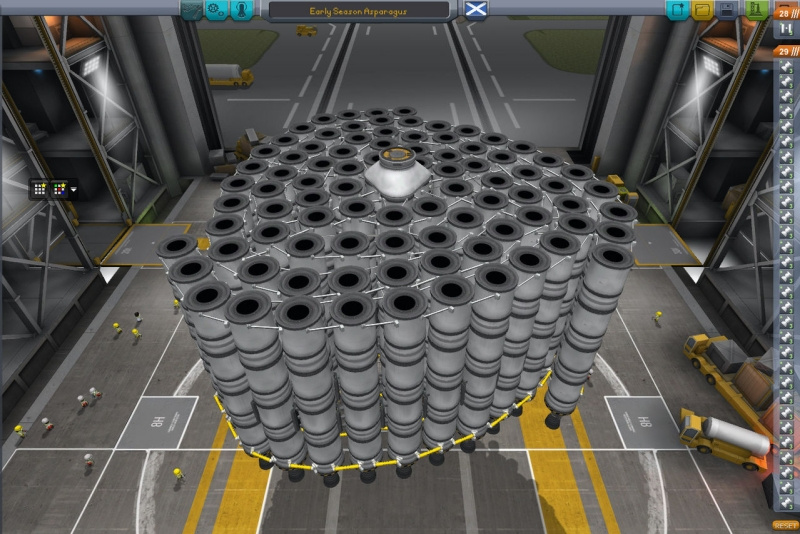
The year 1930 became very important for an engineer, scientist and designer. Friedrich Arturovich began work on the first Soviet rocket engine OR-1. Due to budgetary constraints, it was created on the basis of a blowtorch, but it had all the hallmarks of a real rocket engine and developed thrust up to 5 kg.
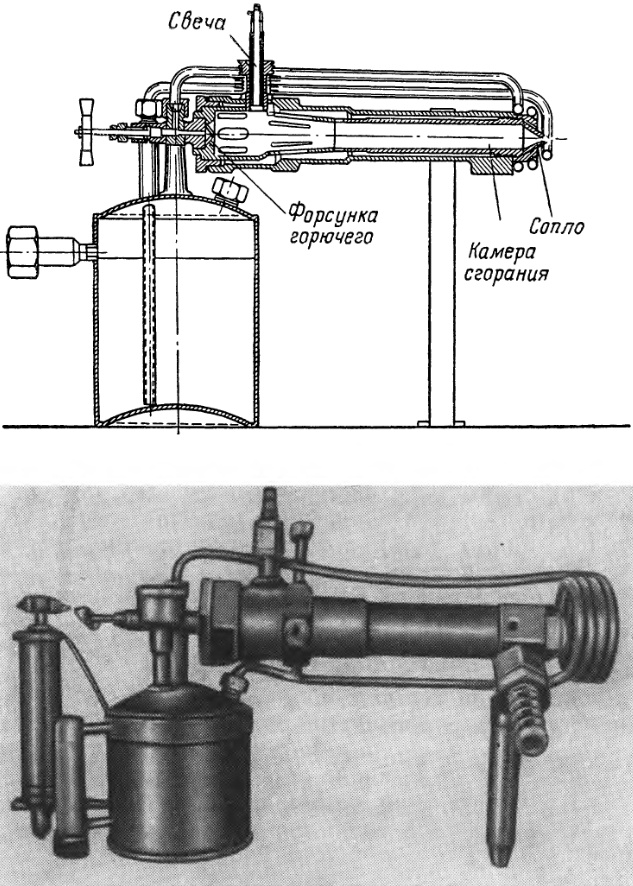
The layout and appearance of the engine OR-1
The engine worked on gasoline and gaseous air. The nozzle did not specifically have an expanding part to study the combustion processes. In addition to gasoline, Zander subsequently experimented with burning metals in this engine. Also in the diaries there is information about the use of different experimental nozzles. Due to the fact that the engine used gaseous air, it was sometimes mistakenly assumed that it was not a liquid rocket engine, but air-reactive, but the design and test methods clearly say that it was the LRE.
The first fire tests of the OR-1 engine took place on September 18, 1930 and became a great event for the pioneers and enthusiasts of the Soviet cosmonautics.
At the beginning of 1931, Zander organized a section of jet engines at the Bureau of Aeronautical Engineering of the Central Council of Osoaviahima, which then turned into a GIRD - Group for the Study of Jet Movement. Zander heads the first brigade (engines). The fourth brigade (aircraft structures) was headed by S.P. Korolev.

In 1931-32, Zander, Korolev, and Boris Cheranovsky worked on a rocket plane. The tailless gliders of Cheranovsky seemed to be perfect for installing a rocket engine.

Boris Cheranovsky and Sergey Korolyov at BiCh-8
A real OR-2 engine with a design pitch of 50 kilograms was prepared for the device, the nozzle was cooled by water, and the combustion chamber was prepared with gaseous oxygen.
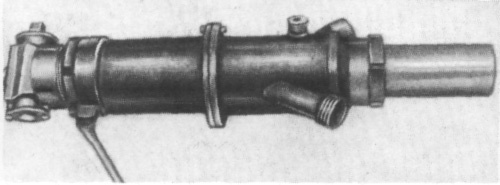
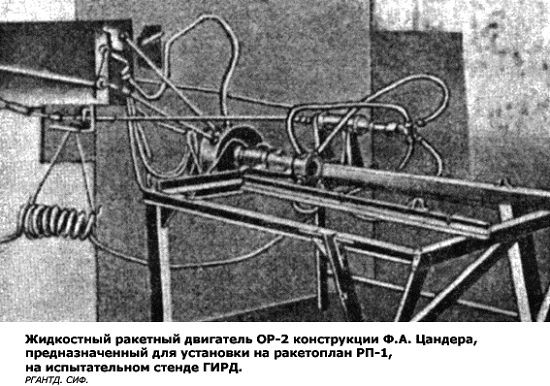
Zander also worked on the GIRD-X rocket (“GIRD-ten”).
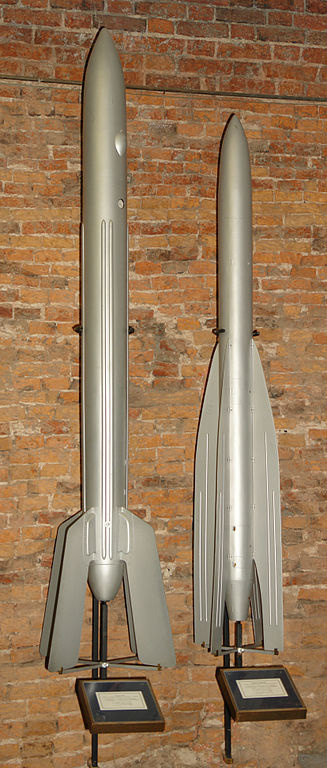
On the left - GIRD-09, the first hybrid fuel rocket (jelly rosin solution with gasoline), on the right - GIRD-X, the first rocket with LRE, photo by George Shuklin / Wikipedia
The anecdotal stories about Zander’s love regularly exclaim to the period of work in GIRD “To Mars! Go to Mars! ”And tragicomic stories about how much he worked.
But, of course, such hard work could not but affect the state of health of Zander. In the sanatorium, where he was sent in March 1933, they managed to write down in the first days: “The doctor discovered pain in the region of the heart during anxiety and nervous tension, general weakness (sometimes fell asleep right behind the desk), sometimes headaches in the frontal and occipital parts. It turned out that F. Zander suffered from frequent sore throats. " According to other sources
In the first days of their stay in the sanatorium, Zander felt bad, at first they suspected a cold, but the designer got worse, a rash appeared on his body, and with the diagnosis of typhus Zander was hospitalized in an infectious diseases hospital. Friedrich Arturovich Zander died at 6 am on March 28, 1933. He was buried in Kislovodsk.
Most likely, Zander became infected with typhus on the train - to save money, he was traveling in a (seated) car. Surely influenced by the total depletion of the overwork, weakened the body. It is possible that if he observed a reasonable balance of work and rest, his body could cope with the disease.
Already after the death of Zander, tests of the OR-2 engine began, and in the fall of 1933 the GIRD-X rocket flew. In memory of him, a crater was named on the far side of the moon, a street in several cities of the former USSR.
In 2015, Roscosmos TV made a small video biography.
In the network you can find a video of visiting the Zander Museum in Riga.

The house where Zander spent his childhood, photo Smig / Wikipedia
Friedrich Arturovich Zander was born on August 23, 1887 (August 11, 1887) in a family of intellectuals in Riga. My father came from a merchant family and worked as a doctor, his mother came from a family of a musician. Frederick was the fourth child. When he was two years old, his mother died in childbirth. Father married a second time, but actively participated in the upbringing of children. Zander wrote in his autobiography:
Since childhood, I loved to stand by the window and look at the stars on dark winter evenings. My father was a great lover of natural science, for several years he worked actively in the museum, in which he showed us stuffed birds and animals of various breeds, as well as skeletons and parts of fossil antediluvian animals and meteoric stones that fell from the sky.
In 1894, when I was seven years old, he traveled to Baku and the Transcaspian region and brought all sorts of crabs, lizards, monitor lizards, turtles, snakes, etc., from there. We, children, of course, strongly perceived all this. At the same time, we were told about what the stars, the Moon and the planets are, and added at the same time that there one can find new animals of a more bizarre form. The children hear only half of what was said, so I remember, I was very upset and even cried when I was told that it was still impossible to fly there.
His father’s comrades were sailors, Frederick had been to the nautical school, met navigational instruments and was interested in astronomy. My father had a large library in which Zander most of all loved Jules Verne - “From the Earth to the Moon” and “Around the Moon”. In general, it is worth noting that Jules Verne was noted in the biographies of many pioneers of rocket technology, his books, albeit after thirty years, finally got a generation that began to embody the dreams of space travel.
In 1896, Friedrich was identified in a private preparatory school. My father’s personal abilities and help allowed us to study a three-year program in two years. In 1898, Zander was enrolled in the first class of the Riga City Real School (the closest modern analogy is the College of Technical Sciences).
The stories about the flights of G. Lilienthal in Germany and the high kites launched by my father aroused in me an early question: would it be possible for me to try to fly to other planets myself?
In the last class of the school before the winter holidays, our teacher read us a part of an article written by K.E. Tsiolkovsky in 1903, entitled "The study of world spaces with jet instruments"
In 1905, Zander graduated from college as the best graduate and, according to the privilege granted to the first graduate, was enrolled in the mechanical department of the Riga Polytechnic Institute. Alas, frightened by the revolution of 1905, the administration temporarily closes the institute, and Zander leaves for Danzig (now Gdansk, Poland), where he is a student at the Higher Technical School in the engineering department. In 1907, the institute was reopened, and Zander returned to the “alma mater”, where he studied until 1914.
In parallel with his studies in 1908, he participates in the activities of the First Riga Student Society of Aeronautics and Flight Engineering, where he builds gliders and promotes the idea of flying heavier than air vehicles.

1908, the glider was built by the society, Zander on the left
September 18, 1908 Zander turns on a special notebook “Space (ether) ships that will provide communication between the stars. Movement in the world space ", which regularly records calculations and ideas on space issues. Over time, the notebook turns into a unique reference book, and if it were published in the 20s, Zander could have received world fame. Alas, it was not done. Worse, Zander kept records with a shorthand code, and so far not all the information from the exercise book has been deciphered.
In 1909, Zander was overshadowed by the idea of using spent rocket stages as fuel. Winged vehicles and the idea of burning metal in a rocket engine will be noticeable throughout its subsequent work. Until now, mankind has not reached such a level that in flight it can disassemble the previous stage and burn it in the engine of the next stage, but the idea of a wasteless space flight is in principle correct.
In the same year there was a confrontation of Mars. On the wave of public interest, the aeronautics society is actively and successfully engaged in the popularization of astronomy. In 1910, the comet of Halley appears very much in place, and in 1912 a solar eclipse occurs. These events are also used for popularization.
In 1910, Zander comes up with options for a space elevator - a station hanging at the point of equal attraction of the Earth and the Moon, or even a connection of the Earth and the Moon with a cable. But the calculations are implacable - the best steel of that time will not withstand such loads. Now, by the way, materials have appeared that can be used to build a lunar space elevator, and these are not metals, but Kevlar / daynema / aramid from which lines are made.
In June of the same year, Zander proposes to use the Earth’s magnetic field for the motion of spacecraft. This idea has now been successfully implemented - the magnetic field is used to orient the satellites , and experiments are conducted with acceleration / deceleration based on it.
In 1912, Zander independently came up with the idea of dropping the spent rocket stages. I remind you that Tsiolkovsky offered fuel overflow between individual ships. Only Goddard has this idea fixed earlier (in 1909).
In 1914, Friedrich graduated with honors from the institute and got a job at the “Provodnik” factory. The diploma with honors gave a wide freedom to choose a specialty, and Zander wanted to work with rubber, because it would have to play a large role "in the manufacture of airtight clothing, etc., items necessary for interplanetary travel." In 1915, because of the First World War, the plant was evacuated to Moscow, then, after the revolution, they were liquidated, but Zander did not return to Riga, “because Moscow with the Khodynsky field is an aviation center” . Turning slightly aside, the Khodynka field became an important milestone in the life of more than one pioneer of the Soviet rocket science, and B.Ye. Chertok.
In the years 1915-1917, Zander conducts experiments with greenhouses of "aviation lightness", studying the life support of spacecraft, growing vegetables in charcoal. The manuscript is kept in the archives on 163 pages with the results of the work, but, alas, again in the shorthand record. In 1917 he conducted experiments with molten metal, studying the possibility of using it in a rocket engine.
In 1919, arranged for the plant "Motor". Many papers on the first Soviet aircraft engines store his calculations. Participates in the development of engines M-11, M-15, M-26 and others. In the same year, he invents and sends to the General Directorate of Aviation Plants and the Directorate of the Air Force a project of an injection jet engine working on liquid oxygen and oil. The injector was invented before it, but the perspective of this type of fuel injection into the cylinder at that time was not obvious. Repeatedly makes reports on the engine, and experience with liquid oxygen will be very useful to him later.
At the end of 1921 or the beginning of 1922, he meets with Vladimir Lenin and talks with him about interplanetary communications. Zander later noted that he was struck by Lenin’s enormous horizons and his energy. At least partly influenced by this meeting, Friedrich Arturovich took an annual unpaid leave to work on an interplanetary spacecraft project. During work without a salary, he falls into need, he is forced to sell a telescope. The workers of the plant "Motor" from his salary deduct him a two-month salary. A year later, in general terms, finishes the project and returns to the plant.
The result of the work being done since about 1920 is the project of a winged spaceplane. In the dense layers of the atmosphere, he had to use a highly efficient piston engine, rising into rarefied layers - switch to rocket. At the acceleration site, the main wings were to be drawn into the hull, disassembled and used as fuel. The spaceplane should have had small wings to land back to Earth. In space, it was proposed to use the solar sail. At each stage of the flight, the most efficient engine would work, and the aerodynamic quality of the vehicle would also be maximally used.

The appearance of the spaceplane Zander
By 1924, the project was completed, Zander began to make presentations, filed the author's application for the invention, and also published an article in the journal "Technology and Life." He participates in a three-day dispute about flights to other worlds.

Dispute billboard
In the same year participates in the creation of the Society of interplanetary communications.
In the years 1925-1926, in parallel with his work, Zander is engaged in popularization - lectures in Leningrad, Ryazan, Tula, Kharkov, and Saratov attend lectures. Lectures are a great success, after the performance disputes begin. Alas, in 1925, the Society of Interplanetary Communications falls apart.
In 1927, the first World exhibition of interplanetary vehicles and mechanisms opened in Moscow. The exhibition was small and budget, but this was more than offset by the epic ( here more with the photo ). To an untrained person, it seemed that the Universe was already in his pocket. Alas, at the exhibition were presented mock-ups of projects, which in the overwhelming majority have not yet flown, but only thirty years left before the first satellite. In the corner of the room was Zander's stand.

By 1928, the project includes a composite rocket with a lot of side blocks with engines and tanks with fuel.

In reality, it did not materialize, but such schemes are often created in the Kerbal Space Program, because they are really effective. Next time you play KSP, remember Zander ...

The year 1930 became very important for an engineer, scientist and designer. Friedrich Arturovich began work on the first Soviet rocket engine OR-1. Due to budgetary constraints, it was created on the basis of a blowtorch, but it had all the hallmarks of a real rocket engine and developed thrust up to 5 kg.

The layout and appearance of the engine OR-1
The engine worked on gasoline and gaseous air. The nozzle did not specifically have an expanding part to study the combustion processes. In addition to gasoline, Zander subsequently experimented with burning metals in this engine. Also in the diaries there is information about the use of different experimental nozzles. Due to the fact that the engine used gaseous air, it was sometimes mistakenly assumed that it was not a liquid rocket engine, but air-reactive, but the design and test methods clearly say that it was the LRE.
The first fire tests of the OR-1 engine took place on September 18, 1930 and became a great event for the pioneers and enthusiasts of the Soviet cosmonautics.
At the beginning of 1931, Zander organized a section of jet engines at the Bureau of Aeronautical Engineering of the Central Council of Osoaviahima, which then turned into a GIRD - Group for the Study of Jet Movement. Zander heads the first brigade (engines). The fourth brigade (aircraft structures) was headed by S.P. Korolev.

In 1931-32, Zander, Korolev, and Boris Cheranovsky worked on a rocket plane. The tailless gliders of Cheranovsky seemed to be perfect for installing a rocket engine.

Boris Cheranovsky and Sergey Korolyov at BiCh-8
A real OR-2 engine with a design pitch of 50 kilograms was prepared for the device, the nozzle was cooled by water, and the combustion chamber was prepared with gaseous oxygen.


Zander also worked on the GIRD-X rocket (“GIRD-ten”).

On the left - GIRD-09, the first hybrid fuel rocket (jelly rosin solution with gasoline), on the right - GIRD-X, the first rocket with LRE, photo by George Shuklin / Wikipedia
The anecdotal stories about Zander’s love regularly exclaim to the period of work in GIRD “To Mars! Go to Mars! ”And tragicomic stories about how much he worked.
Most of the GIRD employees, including Korolev himself, worked in the basement first on a voluntary basis in the evenings. Those who worked in the evening shift came in the morning. So one morning, designer Viktor Alekseevich Andreev came to the basement in the morning and saw Zander sitting above the papers. Noticing Andreev, Friedrich Arturovich asked absently:
- What? Is the working day already over?
After that, Korolev promulgated a verbal order, according to which the last one leaving the brigade leaders had the right to leave only with Zander.
Sometimes Zander completely forgot about the family, about the house. Then he was forcibly dressed in a leather coat with a fur collar and sent home. But even when they were escorted to the tram stop, he somehow sneaked back into the basement after half an hour. L. K. Korneev wrote in his memoirs:
“Seeing that Friedrich Arturovich was very tired and slept as they say, on the move, he was given an“ ultimatum ”: if he doesn't go home right now, everyone will stop working, and if he goes and sleeps, then everything will be ready in the morning, and his arrival will begin trials. No matter how he argued, Zander objected to his departure, the brigade was relentless. Soon, unnoticed by everyone, Zander disappeared, and the team began to work even more intensively. Five or six hours passed, and one of the mechanics, not without solemnity, exclaimed loudly: “Everything is ready, put up pressure, you give Mars!”
And suddenly everyone was stupefied. The trestling couch standing in the depths of the basement fell over with a crash, and F. A. Zander jumped out. He rushed to embrace everyone, and then, laughing, said that he nestled behind the couch and from there watched the work, and since he was bored, he managed to finish a number of calculations and had a great rest. ”
But, of course, such hard work could not but affect the state of health of Zander. In the sanatorium, where he was sent in March 1933, they managed to write down in the first days: “The doctor discovered pain in the region of the heart during anxiety and nervous tension, general weakness (sometimes fell asleep right behind the desk), sometimes headaches in the frontal and occipital parts. It turned out that F. Zander suffered from frequent sore throats. " According to other sources
Zander looked very tired, thin, haggard. In the dining room where they ate, the Gird members soon noticed that Zander was taking the cheapest food. Korolev offered to collect money and secretly from Zander to pay for it in advance. Friedrich Arturovich still paid his 7 kopecks, but received dishes for 35 kopecks. And I could not get enough of everything: “How much better we began to feed in our canteen!” EK Moshkin was a vegetarian, gave him meat. Zander took it with gratitude. From the dining room in an iron jar with a wire handle, he carried porridge to the basement for the evening. In one of the drawers of the table were kept in it some crusts, crackers. Sometimes he opened a drawer, looked in there and spoke with a smile:
- The mouse was ...
And sometimes with surprise:
- Oh! Where did I get the cutlet here?
Korolev ordered Fridrih Arturovich to bring tea and sandwiches in the evening.
Korolev was twenty years younger than Zander, and in life he looked the other way around - he seemed to take care of him. He also obtained a ticket to Kislovodsk, to a sanatorium ...
In the first days of their stay in the sanatorium, Zander felt bad, at first they suspected a cold, but the designer got worse, a rash appeared on his body, and with the diagnosis of typhus Zander was hospitalized in an infectious diseases hospital. Friedrich Arturovich Zander died at 6 am on March 28, 1933. He was buried in Kislovodsk.
Most likely, Zander became infected with typhus on the train - to save money, he was traveling in a (seated) car. Surely influenced by the total depletion of the overwork, weakened the body. It is possible that if he observed a reasonable balance of work and rest, his body could cope with the disease.
Already after the death of Zander, tests of the OR-2 engine began, and in the fall of 1933 the GIRD-X rocket flew. In memory of him, a crater was named on the far side of the moon, a street in several cities of the former USSR.
In 2015, Roscosmos TV made a small video biography.
In the network you can find a video of visiting the Zander Museum in Riga.
Sources and additional reading
- Zilmanovich D.Ya., Pioneer of the Soviet rocket science F.A. Zander, Military publishing house of the USSR Ministry of Defense, Moscow, 1966.
- http://epizodsspace.airbase.ru/bibl/golovanov/doroga/18.html
- http://epizodsspace.airbase.ru/bibl/n_i_j/1987/8/tsander.html
- http://adsl.kirov.ru/projects/articles/2012/03/23/mars-krasnaya-planeta/
- http://epizodsspace.airbase.ru/bibl/tm/1962/9/tsander.html
- http://www.space.hobby.ru/firsts/tsander.html
All Articles